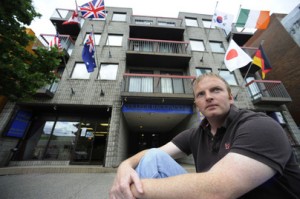Irish job-seekers hope for greener pastures in Canada

Like the many Irish migrants who arrived years before, Seamus Blake left his tiny coastal village in Ireland five weeks ago in search of greener pastures in Toronto.
No potato famine or decades-long political conflict drove him here.
Instead, a steady influx of young Irishmen and women like Blake, 24, is arriving here in desperate search of work, fleeing their country’s 14 per cent jobless rate, an after-effect of the 2008 global financial crisis and economic recession.
After spending a month at a backpackers’ hostel in Kensington Market, Blake moved into an apartment last week and, armed with a one-year work permit, started his job search. Hostel operators catering to young travellers in Toronto say as many as half of their residents over the past 18 months are visitors from Ireland looking to start a new life here.
Blake, 24, who graduated from Leeds University with a master’s degree in financial mathematics last year, arrived a year after his older brother David landed in Vancouver, also with a work permit.
“At the moment, there doesn’t seem to be any jobs for new graduates in Ireland,” said a despondent Blake, a native of tiny Liscannor, on Ireland’s west coast. “From what I heard, Canada’s economy has already bounced back and it’s full of opportunities.”
Latest statistics show the number of temporary foreign workers in Canada from Ireland — the class most recent newcomers arrive under — jumped from 1,514 in 2004 to 2,604 in 2008. Community leaders say those figures don’t begin to reflect the recent surge in Irish arrivals.
According to the London-based National Economic and Social Research Institute, some 18,400 Irish nationals emigrated in the year ending April 2009, mostly to Commonwealth countries. The exodus is expected to last for at least two more years.
Karl Gardner, deputy head of the Embassy of Ireland, said Irish people have a long tradition of adventure and migration. While the island’s population stands at 4.5 million, there are an estimated 75 million people of Irish descent around the world, including 4.35 million in Canada.
“We have always travelled,” Gardner said from Ottawa. “The sense is it is something that we do.”
Eamonn O’Loghlin, executive director of the Ireland Canada Chamber of Commerce in Toronto, receives several emails and phone calls a week these days from his countrymen, some his “lost friends and relatives,” exploring prospects in Canada.
“I try to be realistic and tell people that the job market is tight here as well, but it is easier if you have the education, skills and network in business,” said O’Loghlin, who followed his Canadian wife, Madeleine, to Canada in 1975 and never left.
O’Loghlin has met at least 60 new arrivals in the last year helping them connect with his group’s 250 members in GTA. The trade group plans a Welcome to Canada Information Night on June 1 to offer tips about living in Canada, jobs and accommodation. It will start a Facebook group and an employment website later this month to assist new Irish migrants.
Sandra McEoghain, founder of the four-year-old Irish Association of Toronto, said many of her 345 members are recent arrivals ages 24 and 35 here on work permits.
“There’s advertising in Ireland about Canada and some people are falling for that. People realized Canadian banks did really well during the recession and think there have to be more opportunities here,” said the Toronto business system analyst, 38, who came as a skilled immigrant in 2002. “Some of them have to leave fast and it’s much quicker to get a work visa.”
But it is not easy to settle in a new country, even if you share the same language and similar heritage. Most report having problems finding affordable accommodation and jobs without Canadian references.
It took Brian Byrne five months to land a job at an engineering consulting company, after sending out dozens of resumes and doing survival jobs in drywalling and masonry.
Although Irish credentials are generally recognized here, the 33-year-old native from Kilkenny said he had to adapt to the Canadian resume style, pick up colloquial English and spend time building a professional network that ultimately led him to his present job. “It is a full-time job looking for jobs,” sighed the manufacturing engineer.
For Brian Keane, who has a university degree and 11 years’ experience in construction management, his “leap of faith” to leave home turned out to be one of the best decisions he’s made in his life.
“I have guilt for not feeling homesick,” joked the 35-year-old Dublin native, who came here in December after he lost his senior management job in early fall. “I really like the Canadian lifestyle and the people are so friendly, outgoing, welcoming and helpful.
“My advice for those who’d like to move to Canada is: Don’t think twice, but plan it!”
Like other new arrivals surveyed for this story, Keane said he can see himself staying in Canada for good.
Take our FREE Online Assessment Today!
Socialize with Abrams & Krochak
Trinity Bellwoods no longer official G20 protest site

Summit officials have abandoned Trinity Bellwoods Park as the G20’s official demonstration area, but at least one group still plans to rally there in June.
In an about-face Thursday, the G20’s Integrated Security Unit announced it will be moving the protest zone, explaining the change as a response to complaints from area residents and consultations with city hall.
The security unit has yet to announce the new site, but the Ontario Federation of Labour says it’s sticking with Trinity Bellwoods.
The OFL expects thousands to attend its G8 and G20 march on June 26, organized in conjunction with groups such as Oxfam, Greenpeace and the Canadian Labour Congress.
The OFL plan is to meet at Queen’s Park and march along University Ave. and Queen St. W., concluding at Trinity Bellwoods, chosen last week by summit officials as a “designated speech area” for G20 protesters.
“We plan on keeping our rally at the park because nobody has told us otherwise; not the police, not the city,” said OFL president Sid Ryan.
But area residents oppose even this labour rally. At a meeting Thursday night, the Trinity Bellwoods Community Association voted 33-0 against the rally being held in the park.
Resident Steffan Randstrom said he was skeptical the labour rally would only attract peaceful demonstrators. “People will travel here from all over the world to do crazy s—,” he said. “Why do you choose a residential park for such an event? I’ve got kids and I don’t want them to meet crazy anarchists.”
The OFL’s Laurie Hardwick and Toronto police Const. George Tucker, of the Integrated Security Unit, tried to calm their concerns.
“We have no intention of doing any damage to your community,” Hardwick said. She assured them most of the demonstrators would be out of the park by about 4 p.m.
Hardwick estimated the crowd at 5,000, but residents worried the numbers could swell to more than 20,000.
“Why isn’t this happening at the CNE?” said David Ginsberg. With thousands of people in the park, “our kids are not going to be able to play,” he said.
Outside in the park, Anne Louise Pearl, who was walking her dog, said she was happy the designated speech area was being moved from the heavily used park.
But she was also concerned about the OFL rally, noting some recently planted saplings might be damaged. “I still don’t understand why they have to use this park.”
Mark Critoph, a graphic design professor in the park with his daughter Asha, 6, said he supports people’s right to protest and did not want to fall prey to the NIMBY (not in my backyard) syndrome. “I would not attend it, but it’s got to be somewhere,” he said.
Mark Gelineau, manager of Great Stuff, a nearby clothing store, said he felt better upon hearing the park would only host the labour rally, which might attract business, instead of a designated protest zone, which might attract vandals. “Rallies are usually positive things,” he said.
The OFL’s Ryan said his rally venue was chosen prior to summit officials picking Trinity Bellwoods as the designated speech area. He said the OFL worked closely with police to select the site. The federation originally wanted Coronation Park but settled on Trinity Bellwoods after police asked them to find an alternative location that didn’t require marching across the Gardiner Expressway and Lake Shore Blvd.
Ryan said the OFL already has permits for the parade route and Queen’s Park but has only a conditional permit so far for Trinity Bellwoods. However, the federation is already making permit payments and meeting its obligations, even hiring 300 marshals to keep radical protesters from infiltrating its rally.
“City hall has to approve the permit but I can’t see why the Canadian Labour Congress or OFL would have a rally permit turned down,” Ryan said. “That would be highly unusual.”
Summit officials say they have no issue with the OFL using Trinity Bellwoods as long as its permit is approved by the city.
City councillor and mayoral candidate Joe Pantalone said he was “totally unhappy” when Trinity Bellwoods was announced as the protest site. He thinks the park, bordered by homes and families, is no place for protesters.
Pantalone said he brought his concerns to Police Chief Bill Blair, who told him Wednesday the site would be moved. He said Queen’s Park is now being considered for the protest zone.
But for Ryan, the summit is an international event being staged by the federal government — protesting outside the Legislature would be pointless.
“Queen’s Park is not an acceptable site,” he said. “It’s too far away. You don’t even get an opportunity to get down to the perimeter of the security fence.”
He said the OFL wrote a letter to city hall Thursday morning, offering to move the rally if the city would find a more suitable location. Ryan said he has yet to hear back.
Ryan is frustrated with the reaction to the OFL’s use of the park as a rally site and said the group is fully committed to protesting peacefully, as is its democratic right.
“These politicians that are complaining, they stand with us at protests all across the city, all across the country, and then we have a protest and they say, ‘Not in my backyard,’” he said. “It’s ridiculous.”
Meanwhile, NORAD conducted flight tests throughout the day on Thursday in preparation of the G8 and G20 summits. The tests are to continue into Friday.
Take our FREE Online Assessment Today!
Socialize with Abrams & Krochak
Victims Duped by Immigration Fraudster

The law firm of Abrams & Krochak, Canadian Immigration Lawyers, is licensed by the Law Society of Upper Canada (province of Ontario) to provide legal services for persons wishing to immigrate to Canada. Please be aware that there are some immigration consultants that claim to be a legitimate provider of such legal services, but who are not licensed by the Canadian Society of Immigration Consultants (CSIC).
To our Friends and our Fans, please do not be taken advantage of by unlicensed consultants. Begin your legal Canadian immigration today by completing our Free Eligibility Online Assessment at
http://www.akcanada.com/assessment.cfm
Victims Duped by Immigration Fraudster
An uncertified immigration consultant in Windsor has been charged with fraud after 11 clients allegedly paid him thousands of dollars for services they never received.
The victims made payments to the consultant ranging from $2,000 to $100,000 in the belief that applications to immigrate to Canada were being made on their behalf.
But no such applications were ever submitted, said investigators with the
Immigration and Passport Section of the Windsor RCMP.
Eleven counts of fraud have been laid against Francesco Salvatore Sam Burgio, 45, of Amherstburg, Ontario.
Police identified 11 victims, but believe there may be others.
Often, individuals who have been victimized are reluctant to come forward fearing that reporting their situation will interfere with their ability to gain legal immigration status in Canada, Cpl. Rod Rudiak of the Windsor RCMP said in a press release.
The Canadian Society of Immigration Consultants (CSIC) had revoked Burgios license back in 2006.
That should have set off red flags for anybody who was considering hiring him, CSIC Chair and Acting CEO John Ryan said in a release.
Most people would never consider hiring an unlicenced doctor or lawyer, and consumers need to realize that hiring an uncertified immigration consultant is just as unwise, he said.
In reaction to the arrest, Citizenship and Immigration Canada (CIC) Minister Jason Kenney said Tuesday that unscrupulous immigration consultants heap misery upon their victims and pose a serious threat to the reputation of Canada’s immigration system.
The charges against Burgio come just weeks after Vancouver-based consultant Fereydoun Hadad was sentenced to a year in prison after pleading guilty in January to defrauding an Iranian man seeking to immigrate to Canada of over $49,000.
Hadad had convinced the would-be immigrant to set up a bank account in Canada and deposit money in it. By forging the mans signature, Hadad withdrew the funds for his personal use.
Unscrupulous consultants are a significant problem and tackling it requires all levels of government to work together and make it a priority, Kenney said a statement after Hadads conviction.
Preying on people who are desperate to have a new start in Canada, or who are trying to bring their family members here, is unconscionable. As the Speech from the Throne promised, we will be taking steps to address this, Kenney added.
Ryan welcomes a government crackdown on fraudulent immigration consultants, saying legal loopholes permitted the practice to go on for too long with little danger of legal repercussions.
Only members licenced with the CSIC, a provincial or territorial bar, or Quebec notaries may advise or represent clients before the Government of Canada for a fee. However, friends, family, or religious organizations may offer free help.
The CIC website states that the government will not deal with any unauthorized person charging a fee for immigration services. To assist prospective immigrants, the website provides detailed information about e-mail and Internet scams, fake websites, and computer viruses.
Dont be a victim of a scam. If it sounds too good to be true, it probably is, the CIC warns.

Take our FREE Online Assessment Today!
Socialize with Abrams & Krochak
British Columbia Becomes One Step Easier to Immigrate to Canada

Recently Dr. Alice Wong, Parliamentary Secretary to Immigration Minister Jason Kenney, and Moira Stilwell, B.C. Minister of Advanced Education and Labour Market Development, signed the new Canada-British Columbia Immigration Agreement.
Immigation Minister Kenney had the following to say:
“The signing of today’s agreement with British Columbia will support the integration of newcomers, helping to ensure that they’re able to contribute to our economy and succeed in Canada.” He also went on to say “I am also pleased to announce the first temporary foreign worker annex to this agreement today. This will facilitate the entry of these workers to help British Columbia fill critical labour shortages.”
Diane Finley, Minister of Human Resources and Skills Development had the following to say:
“The agreement will help Canada attract the skilled international workers it needs to meet the needs of the Canadian economy as we emerge from the global economic recession.” Minister Finley went on to say “It will certainly strengthen British Columbia’s ability to meet its labour market needs both today and in the future.”
Minister Stilwell had the following to say:
“The renewal of this agreement strengthens our partnership with the federal government and our commitment to providing welcoming and inclusive communities and workplaces in B.C. for newcomers.” Minister Stilwell went onto say; “Immigrants coming to our province not only enrich the social fabric of B.C., they also bring economic advantages, generate innovation, attract industries and workers, and spur economic growth.”
It is the intention that the agreement will lead to improved collaboration between Canada Immigration and British Columbia on immigration matters. The immigration agreement involves community partners, including local governments, service providers and the private sector to help welcome and integrate immigrants into Canadian society. The Canadian Government will be transferring $114 million to British Columbia for immigration and settlement services and for welcoming communities initiatives.
It is hoped that the immigration agreement will result in more immigration intoto British Columbia and will encourage existing immigrants to say. This will help immigrants integrate and help meet British Columbia’s economic and social needs.
Take our FREE Online Assessment Today!
Socialize with Abrams & Krochak
Archives
- November 2025
- June 2025
- March 2025
- February 2025
- December 2024
- October 2024
- June 2024
- May 2024
- April 2024
- January 2024
- November 2023
- July 2023
- June 2023
- May 2023
- January 2023
- November 2022
- April 2022
- March 2022
- February 2022
- October 2021
- June 2021
- April 2021
- October 2020
- September 2020
- June 2020
- May 2020
- April 2020
- March 2020
- December 2019
- January 2019
- December 2018
- November 2018
- August 2018
- June 2018
- April 2018
- January 2018
- December 2017
- November 2017
- April 2017
- January 2017
- December 2016
- November 2016
- October 2016
- September 2016
- August 2016
- August 2015
- January 2015
- December 2014
- November 2014
- June 2014
- April 2014
- March 2014
- February 2014
- December 2013
- May 2013
- April 2013
- January 2013
- December 2012
- August 2012
- June 2012
- March 2012
- January 2012
- September 2011
- August 2011
- July 2011
- June 2011
- February 2011
- January 2011
- December 2010
- November 2010
- September 2010
- August 2010
- July 2010
- June 2010
- May 2010
- April 2010
- March 2010
- February 2010
- January 2010
- December 2009
- November 2009
- October 2009
- September 2009
- August 2009
- August 2008
- July 2008
- June 2008
- May 2008
- April 2008
- March 2008
- February 2008
- January 2008
